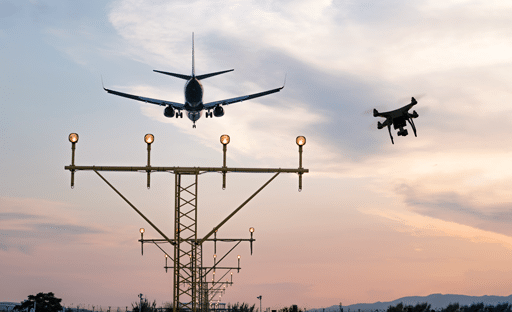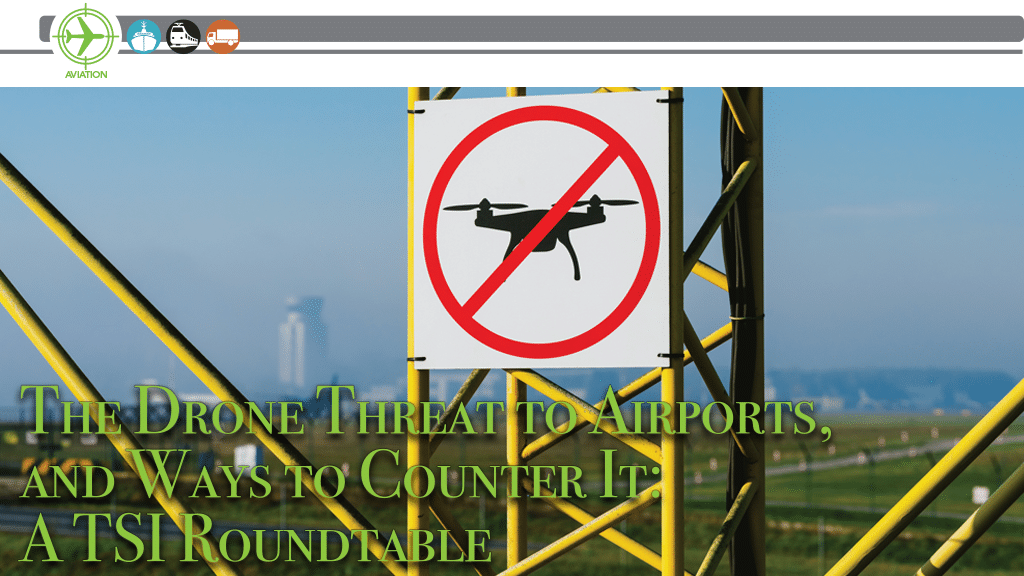As drones become increasingly popular with the public, their intrusion on airport airspace is becoming an increasingly serious problem. To find out what can and is being done to counter the airport drone threat, Transportation Security International (TSI) sat down with two experts in a virtual roundtable. Jeffrey Starr is chief marketing officer with D-Fend Solutions, a global provider of counter drone solutions for sensitive and challenging environments. Leo McCloskey is vice president of marketing with Echodyne, whose radar equipment can be used to detect and track drones.
TSI: Just how serious is the threat of drones impinging on airport airspace?
Jeffrey Starr: First, the physical safety risk is significant. Studies have shown that common commercial drones with heavy payload capacity can cause severe damage to aircraft, including shattered windshields, penetration and inhalation hazards, and lost optics. Ultimately such collisions could require emergency landings.
Even at slow speeds, such collisions could cause plastic damage and extensive deformation to aircraft skin, as well as additional damage to internal structures. At high speeds, collisions could cause severe deformations of slat curvature, damage to the leading edges, and even possible penetration of drone debris into the fractured area.
The implications and economic impact are enormous, as reflected in grounded flights, missed connections, angry passengers, and lost revenues. Indeed, the after-effects of a drone incident can lead to serious consequences and substantial financial costs. Therefore, rogue drones operated by the criminal, careless or clueless create many challenging situations for airports.
Looking at use cases or scenarios; it’s not only routine airport operations that are affected by drone intrusions, but also special situations such as a special event or VIPs traveling, whereby the airport might have to take special precautions against hostile drones, beyond the normal threat to operations.

D-Fend Solutions
Drone threats to airports are not just a routine safety issue. The threat is very dynamic, and airports must prepare for different scenarios depending on its unique traffic flows and day-to-day operational life.

Echodyne
Leo McCloskey: Given the heavy use of aircraft to move people about, anything that jeopardizes the safety of the national airspace system (NAS) is unwelcome. Luckily we’ve had few actual collisions but we are just a bit of bad luck away from a serious incident.
It’s not just the threat from unwanted or intruding drones, though. It’s also about how drones are integrated into the NAS. Without knowing what good drone behavior looks like, determining bad intent is practically impossible. This state of alertness without actual information about drones causes anxiety, which only elevates the risk to the NAS..
TSI: What examples of such incidents can you tell us about?
Jeffrey Starr: Drone sightings and incidents around airports have increased significantly in recent years. Since the beginning of 2023 alone, there have been serious drone incidents at many airports including Edinburgh, Madrid, Palm Beach, Warsaw, Pittsburgh, Frankfurt, and famously, multiple incidents in Dublin, just to point to a few.
At Edinburgh, flight departures were disrupted and delayed due to an unauthorized drone near the runway. A drone also caused delays at Madrid-Barajas Airport when it was spotted by an incoming flight from Paris.
In Palm Beach, a pilot reported a drone right off the side of an aircraft. Flights have also been suspended at least six times since January at Dublin Airport, causing the diversion of flights to other airports.
In Warsaw, an airplane pilot reported seeing a 3-meter-long UAV flying within 30 meters of an LOT Embraer aircraft as it was landing at Chopin Airport.
Operations at Pittsburgh International Airport were suspended for approximately 30 minutes due to reports of an unauthorized drone sighting on the northern section of the airfield.
A drone sighting at Frankfurt Airport caused flight cancellations and delays, including a 40-minute complete shutdown and 20 canceled flights.
These are just some selected recent representative examples of many that have occurred this year alone.
TSI: Why is this happening with drones? What are the range of motives for people flying drones into protected airspace?
Leo McCloskey: There are roughly three types of drone operators.
What we’d want to be the largest type is the licensed and well-behaved drone operator that follows regulatory guidelines for things like RemoteID.
The second type are those that fly with abandon, without really thinking about rules and regulations. Whether a daredevil or simply confused, drone flight outside the norm is always a risk. Not because of malicious intent, just because of risk and probabilities over time.
The final type of drone operator is the bad actor using the drone with intent, whether delivering contraband to prisons or small explosives to jet fueling areas. We need to protect about types two and three and focus our worry and concern on type three..
Jeffrey Starr: As drones proliferate with increased popularity, greater ease of use, and cheaper prices, the likelihood of incidents near airports rises and the risk they pose to airports grows increasingly higher.
There are diverse types of threats. A careless user causing a collision is the most discussed. But more malicious kinds of threats could include an actual attack by a bad actor, or surveillance or espionage, where malicious actors may attempt to observe an airport for potential future violations.
TSI: What options exist for detecting and intercepting drones?
Leo McCloskey: Detecting is different from tracking, which is very different from identifying and then intercepting.
There are many options to accomplish the task. The minimum requirement is at least two sensors that combine to provide detection through identification, typically radar and optical. The most important component of any system, though, is the command-and-control software layer that harnesses the best of all sensors to deliver comprehensive situational awareness.
Jeffrey Starr: There are multiple technologies that can be deployed to help, but what we must consider with airports is that they are an extremely different sensitive environment compared with the surroundings where traditional legacy counter-drone technologies emerged from, namely the military battlefield.
To understand this problem better, it’s important to examine the multiple functions of detection, identification and mitigation.
The risks associated with a drone at airports have caused many airports to start evaluating options for effective and specialized counter-drone technologies that are suitable for the unique and sensitive environments of an airport. However, reaching the desired levels of airspace safety in the context of increasing rogue drone activity has proven to be particularly challenging, since legacy military technology countermeasures have serious issues in a civilian airport environment.
Counter-drone technologies originating from the military realm have performed well in the environment for which they were originally designed. However, when they enter the sensitive airspace of a civilian airport, many glaring shortcomings become apparent.
For drone detection, radar has played a role for a long time, but in an airport environment radar may generate false positives from not always being able to clearly distinguish between a drone and other flying objects such as birds.
Optical camera-based systems for identification require a clear line of sight, which can be difficult in urban environments or hilly terrain. Acoustic methods are challenged by noisy airport environments and increasingly quiet drones.
Traditional radio frequency (RF) based methods such as directional finders may not be able to locate and track the drone to the highest degree of precision.
More importantly, the challenges are even more steep when considering mitigation, especially when again looking at countermeasures that came from the military sector.
Jamming could be prohibitively problematic to a sensitive airport environment, given the possibility for disruption to communications and operations. It’s also temporary by nature, and the rogue drone pilot could regain control when jamming ceases.
Any type of kinetic/physical mitigation method involving shooting some sort of projectile at the drone, carries with it the serious risk of collateral damage, either from the projectile itself or the downed drone and resulting debris.
TSI: What role does your company’s product play in countering the drone threat, and who is using them today?
Leo McCloskey: Radar is the foundation sensor for nearly every counter-unmanned aircraft system (C-UAS), and we make a very high performing radar at commercial prices without military export controls (ITAR). Our radars are used by dozens of C-UAS systems, DOD/MODs, and policing agencies.
Jeffrey Starr: We are pioneers in a new-generation category of C-UAS, namely RF Cyber. RF (radio frequency) cyber technology can help combat the dangers posed by the growing number of rogue drones flying close to or over airports.
All the challenges associated with legacy C-UAS technologies are the reason why we advocate for an approach based on what we call “cyber detection and takeover mitigation,” where the technology can detect communications between the pilot’s remote control and the drone and ultimately, if desired and necessary, and if allowed and performed by authorized personnel, to take over the rogue drone.
With this approach, not only can such technology perform detection in ways that traditional technologies cannot, but, more importantly, major advantages can come into play during mitigation, especially versus the legacy technologies of jamming and kinetic.
Jamming disrupts the communication between the remote control and the drone but brings challenges because it can also disrupt communications of nearby technologies, and its temporary nature is limiting. Kinetic means of shooting down the drone are obviously not optimal in an airport environment because of the huge potential for collateral damages.
RF Cyber takeover represents a safer and more optimal technology because it allows for continuity, potentially preventing a potential incident from becoming an actual incident while allowing airport operations to continue.
TSI: What are the hurdles confronting airports and their suppliers in the use of counter drone technology?
Jeffrey Starr: The technology challenge is to constantly develop and enhance with innovations that can stay ahead of drone technology and develop and update countermeasures as new drone technologies advance, in a never-ending game which combines cat and mouse with leapfrog.
Market and user education is also critical as brand-new UAS and C-UAS technologies emerge since operators come from using traditional technologies. While there is an education process, the good news is that innovative technology such as D-Fend’s EnforceAir is quite easy to operate for qualified security professionals, who become fluent in it quite quickly.
Another challenge is dealing with the unique parameters of each individual airport. C-UAS implementations must conform to each local environment, as there may be legal and regulatory issues in terms of which security agencies can do detection and mitigation. Solutions must adapt to each environment, according to their local requirements and regulations.
Leo McCloskey: The primary obstacle is that interfering with any aircraft operation is illegal. A drone is an aircraft and, therefore, any mitigation activity is illegal. The legal and regulatory framework for detecting bad actors in the airspace is unprecedented territory for regulatory agencies. It will take time.
TSI: What new, more aggressive options are being developed to counter drone intrusions, and how close are they to becoming reality?
Leo McCloskey: There are novel methods, such as high-powered energy weapons, for interdicting rogue drones. The challenge is less technical and far more legal and regulatory.
Jeffrey Starr: Policymakers, regulators, security agencies, and airport operators around the world have been taking steps to deliver strong messages that operating unauthorized drones near airports is illegal, and could lead to financial penalties, criminal charges, and even imprisonment.
An understanding is emerging that during what may be transitory periods for airports, an ideal solution could encompass both passive detection to raise the airport’s situational awareness, with a migration path to eventually extend to also include full, seamless, simple, and safe mitigation capabilities, as policies and regulations permit.
The new-generation counter-drone technology, RF Cyber, is showing promising results for airports for both detection and mitigation. RF cyber-detection solution is showing agility, providing airport security personnel with the ability to quickly adapt.
Unlike various legacy anti-drone technologies, new generation RF cyber-detection detects and tracks both authorized drones and rogue drone threats, providing situational awareness along with a rich set of capabilities, including accurately tracking drone location, home location, and drone operator location.
The system understands the unique identifiers of each drone. Once a drone is classified as ‘authorized’, it would be labelled as such and be allowed to fly undisturbed in defined areas. The ability to distinguish between authorized and unauthorized drones would ensure continuity for drones performing essential functions at the airport. Airport security staff can choose how to utilize the information to contend with the risk and achieve optimal operational continuity.
When permitted by local regulations and policies, and performed by authorized security agency staff, RF-cyber takeover mitigation capabilities can be activated.
Detecting and, when permitted, mitigating the rogue drone threat quickly and efficiently can help maintain safe airport operations. Such a system could assert control over rogue drones and land them safely in a designated zone, as allowed by regulations and performed by the authorized personnel.
Airports could be empowered to detect threats without excessive burden on human resources, disrupting communications systems, or damaging existing infrastructure.
These cyber counter-drone systems must include stationary configurations specially designed for the unique requirements of airports, with enough long-range coverage for airport deployments to protect the airports’ airspace. The sensors must protect the approaching and takeoff air corridors. The hardware should be designed to withstand any extreme environmental conditions of the airports’ location.
Airport security, safety and continuity would be further facilitated by preventing the drone pilot from regaining control over the hostile or rogue drone, thereby smoothly mitigating the threat. Airport authorities could receive preventative alerts while providing crucial data — such as drone takeoff and pilot remote control locations, so authorities can deal with specific flights and dispatch appropriate personnel.

TSI: Finally, is the drone intrusion problem likely to become more serious in the future? If yes, then should airport authorities plan to become more proactive in addressing it? Will they need their own counter-drone force to knock these drones down?
Leo McCloskey: As soon as a tragic accident involving a drone occurs, this will become a very serious issue. Let’s recall what happened after September 11, 2001, — the entire airline industry was grounded for days in one of the largest markets in the world. What do you think will happen if a drone causes a tragic incident?
Jeffrey Starr: Certainly, as airport traffic and capacity grow alongside a proliferation of drones, the problem will grow more severe and dangerous. This combination increases the potential for risk and the potential demand for this kind of technology to be able to take over in those situations.
Having said that, new-generation technology such as RF Cyber is not anti-drone, on the contrary. These enable the new drone economy, so it’s especially important that more sophisticated technologies emerge, which for example can distinguish and identify between a friendly authorized drone and a hostile unauthorized one.
It’s becoming increasingly clear that sensitive airport environments will benefit from advanced and innovative defenses against rogue drones that are also themselves focused on safety and control. Technology should also conform and evolve with current regulations and be future-ready as regulations rapidly evolve to confront the recognized threat.
Airports rely on uninterrupted operations. A new generation of RF cyber detection and mitigation technology could help assure that airport operations continue to run as usual. Continuity prevails as flights, communications, security, and everyday life in the protected airport area proceed smoothly.
